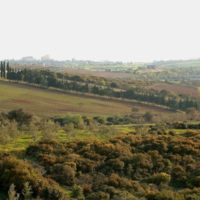Ancient Port Colonization
Point Item Type Metadata
Latitude
40.873466
Longitude
25.508069
MobileContent
The exploitation of the rich Thracian inland, and activities such as the grain production, cultivation of olive trees and especially vines, but also the extensive livestock, (an occupation of the inhabitants even at present), in combination with trade, brought great economic growth and prosperity in the ancient city.
On the ground floor of the Archaeological Museum of Komotini there are several tombstones exhibited, on which you can see the different types of occupations of the people of the ancient city, for example you will be able to spot doctors but also greengrocers.
At this point we should state, that another proof of the growth and development of the city could also be the coinage of Maronia, where its coins were widely spread in all the known ancient world. The metal was guaranteed by commercial trading.
The beginning of coinage in the city took place during 520-515 BC. On the front side of the coins, the representation is associated with the worship of Dionysus and also with the cultivation of vines.
Moreover, there was also a representation of a horse, which is another symbol of the city, and is connected with Kikones. On the back side, there is a variation of representations so we could see bunches of grapes, rams, concave squares with crosses but also the figure of Hercules.
On the ground floor of the Archaeological Museum of Komotini there are several tombstones exhibited, on which you can see the different types of occupations of the people of the ancient city, for example you will be able to spot doctors but also greengrocers.
At this point we should state, that another proof of the growth and development of the city could also be the coinage of Maronia, where its coins were widely spread in all the known ancient world. The metal was guaranteed by commercial trading.
The beginning of coinage in the city took place during 520-515 BC. On the front side of the coins, the representation is associated with the worship of Dionysus and also with the cultivation of vines.
Moreover, there was also a representation of a horse, which is another symbol of the city, and is connected with Kikones. On the back side, there is a variation of representations so we could see bunches of grapes, rams, concave squares with crosses but also the figure of Hercules.
SpeechContent
Let us picture now, that the exploitation of the rich Thracian inland, and activities such as the grain production, cultivation of olive trees and especially vines, but also the extensive livestock, (an occupation of the inhabitants even at present), in combination with trade,, brought great economic growth and prosperity in the ancient city.
If you ever visit the city of Komotini, and more specifically its Archaeological Museum, remember that on the ground floor of the Museum, there are several tombstones exhibited, on which you can see the different types of occupations of the people of the ancient city, for example you will be able to spot doctors but also greengrocers.
At this point we should state, that another proof of the growth and development of the city could also be the coinage of Maronia, where its coins were widely spread in all the known ancient world. The metal was guaranteed by commercial trading.
The beginning of coinage in the city took place during 520 to 515 BC. On the front side of the coins, the representation is associated with the worship of Dionysus and also with the cultivation of vines.
Moreover, there was also a representation of a horse, which is another symbol of the city, and is connected with Kikones. On the back side, there is a variation of representations so we could see bunches of grapes, rams, concave squares with crosses but also the figure of Hercules.
If you ever visit the city of Komotini, and more specifically its Archaeological Museum, remember that on the ground floor of the Museum, there are several tombstones exhibited, on which you can see the different types of occupations of the people of the ancient city, for example you will be able to spot doctors but also greengrocers.
At this point we should state, that another proof of the growth and development of the city could also be the coinage of Maronia, where its coins were widely spread in all the known ancient world. The metal was guaranteed by commercial trading.
The beginning of coinage in the city took place during 520 to 515 BC. On the front side of the coins, the representation is associated with the worship of Dionysus and also with the cultivation of vines.
Moreover, there was also a representation of a horse, which is another symbol of the city, and is connected with Kikones. On the back side, there is a variation of representations so we could see bunches of grapes, rams, concave squares with crosses but also the figure of Hercules.
Entrance
TextDuration
1:13
Characterization
TH
Files
Collection
Citation
“Ancient Port Colonization,” iGuide Repo, accessed December 5, 2025, http://ubuntu01.ceti.gr/omeka/items/show/1688.
Item Relations
| This Item | dcterms:isPartOf | Item: Ancient Port Colonization |

